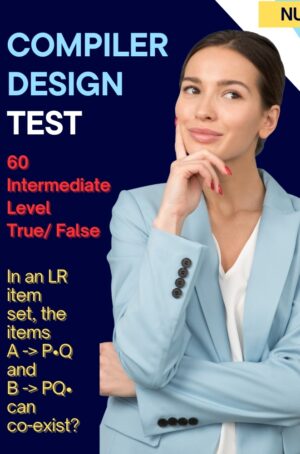Description
Compiler Test: Online Mode, 30 MCQs, 30 Minutes, 60% to Pass
Use the “Compiler Test” to find out how well you know how to design compilers.
With the “Compiler Test,” a thorough online test, you can improve your skills in compiler design. This carefully made test is your chance to show how much you know about compiler design. It is made to test your knowledge and push you.
The compiler test is an interactive trip you can take.
Start an interactive online test trip with the “Compiler Test. You’ll show your problem-solving, critical thinking, and time management skills through 30 multiple-choice questions (MCQs) that have been carefully chosen to test your compiler design skills. Will you be up to the task?
Try to do your best on the “Compiler Test.”
Try to do well on the “Compiler Test” by getting at least 60% of the questions right. This skill shows that you know a lot about compiler design and makes you stand out as a capable person in the field.
Global Significance: The Compiler Test
No matter where in the world you study compiler design or what degree you want to get in India, like B.Tech, M.Tech, BCA, or MCA, the “Compiler Test” is your way to academic success. Compiler design has a lot of potential that you can use to help you get ahead in your schooling.
Your Key to Doing Well on Competitive Exams
The “Compiler Test” is not only useful for normal schoolwork, but it is also a must-have for competitive exams in India like GATE, NET, SLET, DRDO, and ISRO. Sharpen your skills, and you’ll stand out from other hopefuls, putting you on the path to success.
The compiler test is a turning point in the academic journey.
The “Compiler Test” will take you on an educational trip that will change you. Let this test be your first step toward becoming an expert in compiler design and making a big difference in academia and beyond.
Are you up for the challenge?
Are you ready to take on the task? Take the “Compiler Test” today and put yourself on the road to success.
Notice of Copyright
Every right is respected. It is against the law to copy or share this information, in whole or in part, without permission. Copyright rules will be used to punish those who break them. 2023 on Nuutan.com.
Discover an Ocean of Educational Resources! We provide a wide variety of learning materials that you can access through our internal links.
- Nuutan.com is your gateway to a world of information and academic accomplishment. Books in e-book form, multiple-choice question-based online practice tests, practice sets, lecture notes, and essays on a wide range of topics, plus much more!
- Nuutan.com is your one-stop-shop for all kinds of academic e-books, and it will greatly facilitate your educational path.
https://www.nuutan.com/product-category/k12-cuet-iit-jee-neet-gate-university-subjects
- Online multiple-choice tests are available for a variety of subjects on Nuutan.com.
https://www.nuutan.com/product-category/multiple-choice-question
- The Practice Sets on Nuutan.com will improve your performance in any situation.
https://www.nuutan.com/product-category/k12-cuet-iit-jee-neet-gate-cs-btech-mca
- The in-depth lecture notes available on Nuutan.com will significantly improve your academic performance.
https://www.nuutan.com/product-category/k12-cuet-iit-jee-neet-gate-bca-mca-btech-mtech
- Show off your writing chops and gain an edge in educational settings and in the workplace with Profound Essays from Nuutan.com.
https://www.nuutan.com/product-category/k12-competitive-exams-essays
- Nuutan.com is a treasure trove of knowledge thanks to its free academic articles covering a wide variety of subjects. Start your academic engine!
https://www.nuutan.com/nuutans-diary
- Discover our roots and learn how Nuutan.com came to be. Read up about us on the “About Us” page of our website!
https://www.nuutan.com/about-us
- Embrace a Future of Knowledge and Empowerment! is the vision of the future that Nuutan.com has unveiled.
- Become an author by publishing your work on the Nuutan.com platform.
https://www.nuutan.com/create-a-publication-with-us
The External Link Related to This Academic Product:
- GOOGLE BOOKS: Here are a few Google links to help you learn about Compiler Design, including Automata Theory, which is also very helpful for getting a good grasp of Compiler Design.
(1) Mastering Compiler Design: Your Ultimate MCQ Guide to Exam Success
https://books.google.co.in/books/about/Compiler_Design_MCQ_Book.html?id=oZuLEAAAQBAJ&redir_esc=y
(2) Compiler Design MCQs: An Ultimate Practice Book
(3) Automata Theory – A Step-by-Step Approach (Lab/Practice Work with Solution)
- YOUTUBE VIDEO:
https://www.youtube.com/watch?v=5yFdTSbqsWE
- SCRIBD:
https://www.scribd.com/document/489307274/compiler-design-multiple-choice-questions-answers-1-pdf#
- ACADEMIA:
https://www.academia.edu/36463069/Compiler_mcq
- SLIDESHARE:
https://www.slideshare.net/SatyamJaiswal54/compiler-design-quiz
- COURSE HERO:
https://www.coursehero.com/file/129056939/Compiler-MCQ-CS-702pdf/
- BYJU’S EXAM PREP:
https://byjus.com/gate/compiler-design-mcqs/
- DOCSITY:
https://www.docsity.com/en/compiler-design-mcq/7356849/
- OPENGENUS:
https://iq.opengenus.org/compiler-design-mcq/
- STUDOCU:
- GRADUATE APTITUDE TEST IN ENGINEERING (GATE) 2024:
- UGC NET ONLINE (SYLLABUS AVAILABLE ONLINE):
- DRDO (CAREER WEBSITE) – RECRUITMENT AND ASSESSMENT CENTRE (RAC):
https://rac.gov.in/index.php?lang=en&id=0
- ISRO (CAREER WEBSITE):
https://www.isro.gov.in/Careers.html
- STATE LEVEL ELIGIBILITY TEST (SLET) – ASSAM NE REGION:
- STANFORD ONLINE:
https://online.stanford.edu/courses/soe-ycscs1-compilers
- IEEE XPLORE (COMPILER DESIGN RESEARCH PAPERS):
https://ieeexplore.ieee.org/document/7814827
As a result of your constant backing and encouragement, Nuutan.com is extremely appreciative and thankful.










